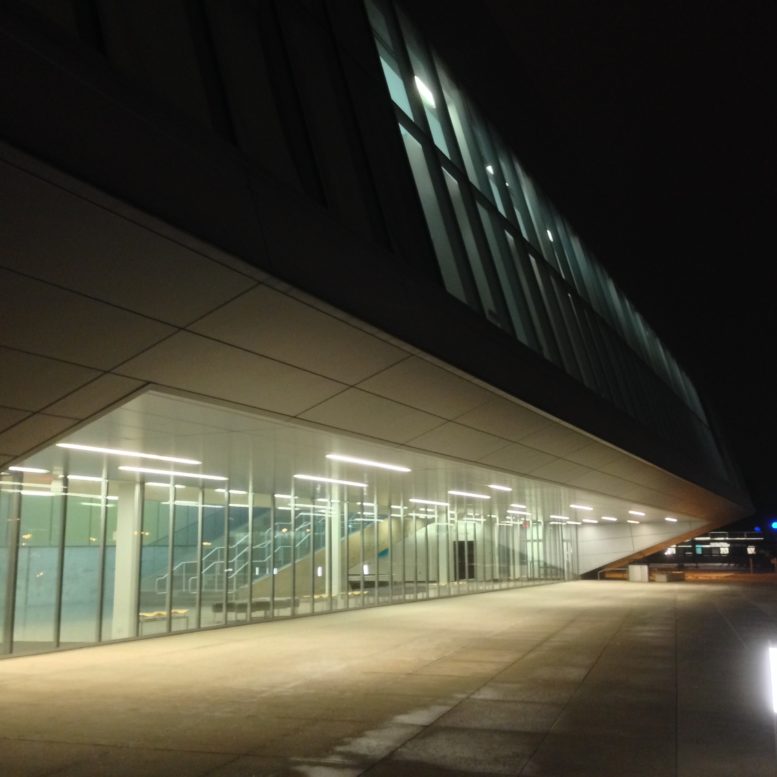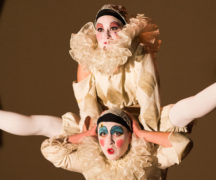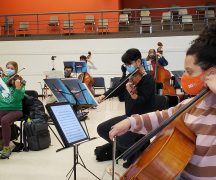By DAVID DUPONT
BG Independent News
The fine and performing arts require up close and personal instruction, the very type of teaching that the coronavirus pandemic, all but rules out.
Lesa Lockford, who chairs the Department of Theatre and Film said her department – and this holds true for the other units – has a double charge. They need to provide students with what they need to continue to make progress toward graduation and they need to do it in a way that’s safe.
“How do we do the hands-on experience that we need so much while also keeping them safe?”
Faculty, staff and administrators are at work figuring out how to use social distancing, protective covering, masks, scheduling, and technology to continue their mission of creating the next generation of creative workers.
“It’s pretty crazy on campus for everybody. You walk through campus and it looks pretty quiet, but behind those walls a lot of buzzing going on,” said Charles Kanwischer, director of the School of Art.
The College of Musical Arts, School of Art, and Department of Theatre of Film will all offer courses in the three formats used university wide – hybrid, remote, and online.
Hybrid mixes face to face instruction with online activities. Remote is a course offered at a specific time period that students will participate in online at that time, or synchronously. Online courses are posted and can be accessed when the student wants, or asynchronously. The latter in all three units is the least likely.
But all three units also have distinctive challenges because of the nature of instruction.
College of Musical Arts
“Like other areas we are working hard to get our first-year students a nice in-person experience,” said Dean William Mathis, of the College of Musical Arts. “So, our music core is all offered in that hybrid model.”
Those courses though will have fewer students enrolled than usual.
That model for instruction is central to how courses will be offered, though some courses will be changed to remote to lower the number of students in Moore Musical Arts Center.
The college already had a handful of online courses.
The smallest of BGSU’s colleges, likely faces the biggest challenges in adapting to COVID-19.
Its students require individual lessons as well as performance in ensembles.
Mathis said the requirement for many students to participate in a large ensemble every semester will be suspended for fall.
The wind ensembles and choirs will rehearse in large party tents outside the perimeter of the building with choirs set up in the courtyard. The courtyard offers good acoustics for the singers, but having wind ensembles out there would be too loud.
All ensembles will be smaller – with bands limited to 30 per class and choirs to a dozen.
The orchestra will perform in the Choral and Kelly rehearsal halls inside. Limited to 20 a session, the ensembles will have strings only, with musicians wearing masks, the dean explained.
The jazz lab bands, which typically have 20 or fewer members, will also rehearse inside.
The ensembles, Mathis said, “will not necessarily be working toward a performance.”
All sessions will be limited to 50 minutes, and “we’re asking at least a half hour of downtime to clear the air again,” Mathis said.
The tents can also be used for musicians to practice, and occasional lessons.
The studios are being rearranged, with some faculty members being moved into classrooms to allow for the space and curtains needed for wind instruments.
All voice lessons will be offered online, however, Mathis said. In some cases, voice lessons may be held if they can be scheduled into large rehearsal spaces. “The studies and the research we’ve looked at show the voice is the most problematic,” Mathis said. “The aerosols that come out of the voice are much smaller, finer, micro droplets, and they linger in the air much longer. So, it’s really not safe to be in a small space with someone singing.”
The college has invested in electrostatic devices to clear the air.
Practice rooms pose a particular issue for the college. Each will be electrostatically cleaned by student workers, which can be done in five minutes after each use.
Each room will be coded as green, ready for occupancy, or red, not ready.
Mathis anticipates the practice rooms will get even more use with students opting to sit there for remote classes rather than going to their rooms.
Department of Theatre and Film
Lockford is looking for “the sweet spot” between giving students the production experience they need in a way that’s safe. “They’re not mutually exclusive,” she said.
Still this is “contested” territory.
On one hand, the International Association of Theatre and Stage Hands has issued a 27-page guidance explaining how “their members can go to work safely,” Lockford said. “They have these protocols. … It is doable with these very weird, confining restrictions.”
On the other hand, the Association of Theatre in Higher Education, which many theater faculty members belong to, “came out saying we should not doing anything in person. It’s not safe.”
That, Lockford said, “leaves us in a pickle.”
The basic and advanced acting classes will be taught in a hybrid fashion, but will focus on monologues with no scene work. Students will wear masks.
And adding singers to the mix “really changes the dynamic,” she said.
So currently – and all the comments made last week are subject to change in an ever-evolving situation – many of the other courses will be offered remotely.
And they do have “a smattering” of online courses, including Introduction to Film.
The department will also be setting up a tent on the back of the Wolfe Center to hold some classes, and possibly performances.
Students will continue to make films, as independent projects or as practicums. They will be guided by faculty with safety protocols as much in place as possible, she said. Those include procedures about handling equipment.
Dance poses a particular risk with bodies leaping around, breathing heavily, and wanting to dance together. The number of dancers in each session and activities will be limited, both for the safety of students and for Colleen Murphy, who will be teaching all the classes.
Some of this may be done remotely. With students filming their work, and Murphy viewing it and then commenting on it.
Ballroom dancing posed too great a challenge – people need to be close together – so will not be offered.
School of Art
“Our enrollment is up quite substantially,” Kanwischer said. That bucks the university-wide trend of enrollment decrease expected to be as much as 5 percent.
The School of Art will see it class of first year students up 10-15 percent. He’s uncertain why, though he speculates it may be students wanting to stay closer to home and others looking for a less expensive option.
Most of the courses will be offered in the remote mode with a few online. But those all will strive to be engaging. “The students need to feel they’re involved.”
However, “the modality of the studio is intense and hands on and experiential,” he said.
He talked about how he teaches in drawing and painting studios. A lower level studio class may have as many as 18 students in it, while an advanced studio may have up to 10. He’ll walk around looking as the students work. He will comment, point out details, and may even make a mark.
“You’re in close proximity,” he said. “At that level it’s one on one engagement, The bulk of the class is spent in close conversation. Replicating that is very difficult.”
Given the size of the studios, some will be able to conduct face to face instruction pretty much as usual with student appropriately spaced out.
Hybrid courses can be offered in a variety of ways.
Some students may not be able to participate in the face to face sessions. So, the faculty member will be teaching simultaneously to them at home or in their residence hall and their peers in the studio. Cameras will be set up to simulcast what’s going on in the studio.
Kanwischer praised the work of the technicians, both in school and at the university’s Information Technology Services, for their work solving a variety of issues, from the physical layout of rooms to managing software licensing.
That includes arranging it so digital art students can access the computers and software in the labs remotely.
“Our tech support staff has been brilliant,” he said.
The school is providing glass students with their own glass blowing pipes and personal protective gear. Digital arts students are each getting a keyboard and mouse.
And the school has invested in UV wands and a UV cabinet for cleaning equipment.
But in the back of everyone’s mind, Kanwischer said, is the possibility that at some point in the semester instruction will be moved entirely online. “That’s what’s making a lot of planning stressful, we’re basically planning two courses,” he said.
“Last semester was an interesting test run,” Kanwischer said. On short notice the faculty had to move all instruction online.
That brought out a lot of creativity, Kanwischer said.
Janet Ballweg who teaches print making bought 20 pasta presses for students to bring home and use to make prints.
Others used the time for research and design projects. Faculty even now are preparing kits that students can take away from campus to continue their work.
Still some disciplines cannot be done at home. Glass blowing is a particular challenge, and chemicals used in ceramics and printing are dangerous in spaces that are not properly ventilated.
“Faculty are totally engaged coming up with great solutions to solving problems,” he said. “No matter how innovative we are, if it’s remote, it’ll still fall short of actually being in the studio.”
Still Kanwischer and the other administrators said that the lessons learned during the pandemic will have an effect on teaching for the long run.
“We’re optimistic,” he said. “We’re feeling as good as we can be. We’ll just have to be as flexible and adaptive as possible.”
(This is the first of two stories on arts and the pandemic at BGSU. A story on the impact on performances will be forthcoming.)





